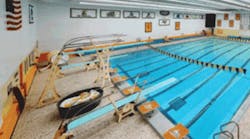Constructed in 1968, the Burdick Hall natatorium on the campus of Towson University in Towson, Md., lacked air conditioning, which resulted in a significant lack of temperature and humidity control. Furthermore, the ventilation equipment was in poor operating condition and well past its economic life.
Swimmers long had complained of respiratory problems, especially an ailment known as "swimmer’s cough." The swim coach knew the source was the buildup of chloramine gas above the water surface. The coach compensated by opening the outside doors and staging pedestal fans at the doorway.
Dennis Bohlayer, associate director of engineering for the university's Facilities Management department, sought to improve the indoor-air quality (IAQ) of the natatorium in the most energy-efficient and sustainable manner possible.
"You only get these opportunities every 20 to 25 years, so you really need to solve the problem well with the long-term objectives in mind," Bohlayer said.
For engineering assistance, Bohlayer turned to Baltimore-based Henry Adams LLC. Senior Mechanical Engineer Nathaniel Krumpe, PE, was cognizant of the need to bring the natatorium up to code in terms of American Society of Heating, Refrigerating and Air-Conditioning Engineers and other standards. Another challenge was handling the requirements of a widely varying number of swimmers and spectators, depending on the type of event.
Solution
The design team believed using high amounts of outside air for ventilation and dehumidification, coupled with the use of flat-plate heat exchangers to recover energy from return air, was the most energy-efficient option. Determined to "evaluate the suppliers not on first cost alone, but, rather, on the basis of total life-cycle cost," Bohlayer and Henry Adams developed detailed requirements that included calculations of projected energy performance based on manufacturer inputs, with verification through factory testing.
I wanted "not just numbers, but to see for myself that the manufacturers' projections were honest and realistic," Bohlayer said.
After an extensive analysis of the bids, the design team awarded the equipment contract to Innovent. The Innovent approach:
- Costs less to operate than traditional systems.
- Requires less maintenance than mechanical dehumidification systems.
- Improves IAQ.
- Increases energy efficiency.
- Interfaces with the campus building-automation system (BAS).
Following the contract award, Bohlayer toured Innovent's manufacturing facility in Minneapolis "to see the attention to detail that goes into the construction—not just regular units in production, but your own unit and witness it undergoing its performance testing." He said he came away "impressed with the quality of the workmanship and the testing procedures and results."
The university pre-purchased a pair of Innovent natatorium dehumidification units for just-in-time delivery in July 2008. But as can happen with complex projects, a contracting issue for the overall pool renovation and equipment installation caused the team to miss the narrow construction window. Consequently, the units were stored in place on the roof until the next construction window, which was the summer of 2009. An Innovent factory expert assisted with unit startup and training of the maintenance staff.
Results
Bohlayer said the difference between the pre- and post-renovation pool environments is like that between "night and day." What's more, the response from the swim coach has been exceedingly positive.
With the units' rugged aluminum construction and high-quality component coatings, Bohlayer expects to avoid the corrosion issues that plagued and disabled the previous HVAC components. He and Henry Adams anticipate ease of maintenance will enable sustainable performance well into the future. With convenient monitoring of natatorium environmental conditions and HVAC units through the campus BAS, Bohlayer can ensure the system is performing to design standards while meeting his expectations for IAQ and energy efficiency.
For Design Solutions author guidelines, call Scott Arnold, executive editor, at 216-931-9980, or write to him at [email protected].









